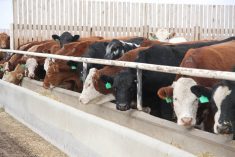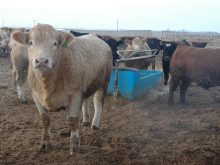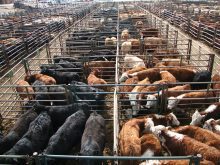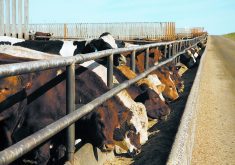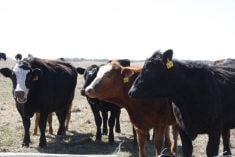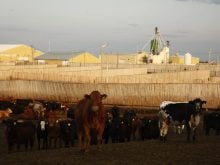This cattle market information is selected from the weekly report from Canfax, a division of the Canadian Cattle Association. More market information, analysis and statistics are available by becoming a Canfax subscriber by calling 403-275-5110 or at www.canfax.ca.
Feds trade lower
Processors have gained leverage over cattle feeders, which is normal for this time of year. Market-ready fed supplies are seasonally increasing and slaughter volumes traditionally peak during the second half of August.
Read Also

VIDEO: Ag in Motion documentary launches second season
The second season of the the Western Producer’s documentary series about Ag in Motion launched Oct. 8.
Light trade was reported last week with weighted average fed prices in the mid $240s per hundredweight, $2 per cwt. lower than the previous week. Trading lower for six straight weeks, the fed market is at the lowest point since April.
The Alberta fed cash-to-futures basis weakened from +$2.60 per cwt. to -$2.05 per cwt. last week. Western Canadian steer carcass weights remain on an upward trend, increasing 15 pounds over the past month. For the second half of August, this is the second largest weight on record. Only in 2022 were they larger.
For August, western Canadian cattle grading B4 have been historically large. For the week ending Aug. 10, they totalled 1,119 head and for week ending Aug. 27 there were 1,083 head. Year to date, B4 grade cattle are 33 per cent larger than a year ago.
In Ontario, dressed sales were reported at $410 per cwt. delivered, $15 per cwt. lower than the previous week.
In the United States, dressed sales in the northern feeding states were at US$292 per cwt., while live sales were at mostly $184 per cwt. Both live and dressed sales were $1 per cwt. lower than the previous week’s weighted average. Sales in Texas and Kansas were at $183 per cwt., fully steady.
For the week ending Aug. 17, U.S beef cow slaughter was slightly more than 47,000 head, 25 per cent lower than last year. For the middle of August, this is the smallest beef cow slaughter since 2016.
Cow price softens
The Alberta non-fed market was mixed last week. Alberta D2 cows closed the week around $1 per cwt. lower at $190.75 per cwt., with D3 cows down $6 per cwt. at $172.76 per cwt. Rail grade cows were mostly steady, ranging between $365-$380 per cwt. Butcher bulls closed the week nearly $2 per cwt. higher, at $212.94 per cwt.
For August, Alberta D2 cows averaged $193 per cwt., 30 per cent higher than last year, while D3 cows were close behind, averaging $178 per cwt., 29 per cent higher than last year.
According to the Canadian Drought Monitor, prairie grass conditions are varied. As of July 31, Saskatchewan and Manitoba were in noticeably better shape than Alberta, with the Peace region and central Alberta hit hardest.
Beef cows will soon be coming to market for the fall cull cow run, and a seasonal softer price trend is ahead.
In Ontario, D2 cows closed last week $3 per cwt. softer at $174.84 per cwt. and D3 cows were down $2 per cwt. For the last week of August, cull cow volumes (beef and dairy) through auction marts were the smallest on record going back to 2019. Dairy Farmers of Ontario issued two milk incentive days in August, which kept dairy cows in the milking rotation.
Feeders under pressure
Alberta auction volumes were 34,649 head, seven per cent above the five-year average and the third largest volume for the same week in the last decade.
Alberta feeder steers remained under pressure last week, trading $1.90-$7.82 per cwt. lower than the previous week, with only 600-800 lb. steers holding steady to $5.36 per cwt. stronger. Heifers traded softer across the board from $3.51 to $9.71 per cwt. lower than the previous week.
Feeder prices have likely peaked slightly earlier than in past years. When looking at the futures market, the September feeder contract has dropped by $13.60 per cwt. between Aug.1 and Aug. 22, putting pressure on the feeder market. Despite the softer feeder market, from the first week of the year to now, 550 lb. and 850 lb. steers have gained $46.90 per cwt. and $33.63 per cwt., respectively, while 550 lb. and 850 lb. heifers are up by $46.67 per cwt. and $50.84 per cwt., respectively.
Yearlings are steady with year-ago prices, while calves retain a 10 per cent premium over last year.
For the week ending Aug. 17, feeder cattle exports to the U.S. were 1,807 head, down 52 per cent from last year. It was the ninth consecutive week that exports to U.S. were below last year.
The fall run will bring larger auction volumes. The feeder market continues to face pressure and has potentially reached its peak.
Cutouts take dip
In U.S. beef trade, cutouts softened a modest two per cent last week. Choice closed at US$308.66 per cwt. and Select at $296.19 per cwt.




